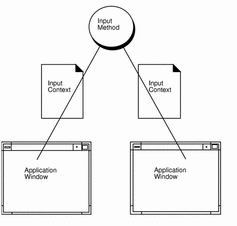Input Contexts
Xlib provides the ability to manage a multithreaded state for text input. A client may be using multiple windows, each window with multiple text entry areas, with the user possibly switching among them at any time. The abstraction for representing the state of a particular input thread is called an input context. The Xlib representation of an input context is an XIC. See Figure 5-1 for an illustration.
Figure 5-1 Input method and input contexts

An input context is the abstraction retaining the state, properties, and semantics of communication between a client and an input method. An input context is a combination of an input method, a locale specifying the encoding of the character strings to be returned, a client window, internal state information, and various layout or appearance characteristics. The input context concept somewhat matches for input the graphics context abstraction defined for graphics output.
One input context belongs to exactly one input method. Different input contexts can be associated with the same input method, possibly with the same client window. An XIC is created with the XCreateIC() function, providing an XIM argument, affiliating the input context to the input method for its lifetime. When an input method is closed with the XCloseIM() function, no affiliated input contexts should be used again (and should preferably be deleted before closing the input method).
Considering the example of a client window with multiple text entry areas, the application programmer can choose to implement the following:
-
As many input contexts are created as text-entry areas. The client can get the input accumulated on each context each time it looks up that context.
-
A single context is created for a top-level window in the application. If such a window contains several text-entry areas, each time the user moves to another text-entry area, the client has to indicate changes in the context.
Application designers can choose a range of single or multiple input contexts, according to the needs of their applications.
- © 2010, Oracle Corporation and/or its affiliates
